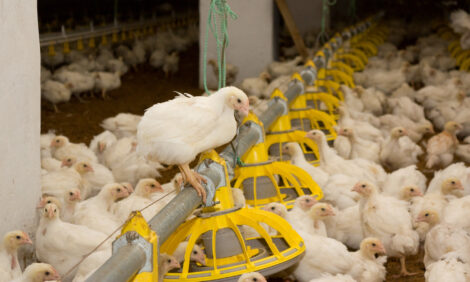



Brazil Poultry and Products Semi-Annual Overview - February 2007
By the USDA, Foreign Agricultural Service - This article provides the poultry industry data from the USDA FAS Poultry and Products Annual 2007 report for Brazil. A link to the full report is also provided. The full report includes all the tabular data which we have ommited from this article.Report Highlights:
Post increased the production estimate for broilers in 2007 by nearly five percent to reflect a projected rebound in exports of 10 percent, and firm domestic demand supported by higher economic growth and higher purchasing power of Brazilian consumers. However, some constraints, such as the current overvaluation of the currency combined with higher feed costs due to the impact of ethanol production on corn prices, could hamper the optimistic forecast for broiler expansion this year.Executive Summary
Post projects Brazilian broiler production to expand in 2007, after stagnating in 2006. The increase in broiler production will likely be driven by a rebound in broiler exports and firm domestic demand supported by an economic growth in the range of 4 percent, lower inflation, a drop in unemployment and higher real income. Market analysts, however, point out some constraints that could adversely impact on production and trade of Brazilian poultry in 2007. They are: further appreciation of the Brazilian currency relative to the U.S. dollar, which could adversely impact packers’ profitability due to the relative increase in production costs, principally because of higher corn and soybean prices. Although Brazil is free of Avian Influenza, the country is in the path of some migratory birds. As of today, the Ministry of Agriculture has been very slow to implement the official plan to deal with a possible outbreak of Avian Influenza, the so-called Regionalization Plan. The main allegation is the lack of government funds. However, Brazilian poultry packers have moved forwarded and implemented an industry preventive plan against Avian Influenza.Production
Post revised upwards broiler production in 2007 to 9.8 million metric tons; nearly five percent higher than last year’s production. The 2007 increase in broiler production reflects mostly a projected recovery in the exports of broilers, principally cuts and processed broiler meat. In addition, firm domestic demand derived from higher employment rate and consumer purchasing power, supports a continued boost for animal protein. Also, continued expansion of broiler exports to new markets is projected due to strong market promotion efforts jointly conducted and financed by the Brazilian government agency for market promotion.The major constraints that could adversely affect broiler production and exports in 2007 are:
a) continued appreciation of the Brazilian currency;
b) increase in feed costs due to higher corn and soybean prices that can reduce producer’s profit margins; and,
c) an outbreak of animal diseases.
Post also revised broiler production in 2006 to reflect final production data obtained from the trade. In 2006, broiler production reached nearly 9.4 million metric tons, the same level as in the 2005. The increase in broiler production in 2006 was mostly supported by increased domestic consumption since broiler exports dropped for the first time since 1998.
Trade
Post revised upwards broiler exports in 2007 to reach 3 million metric tons, up 10 percent from the volume exported in 2006. The projected increase of broiler exports in 2007 is attributed to a recovery in the international market of poultry consumption as consumers overcame the scare of Avian Influenza. Also, because of the recent outbreak of Avian Influenza in Great Britain, Brazil is expected to supply more chicken to Europe and other markets, such as Russia, Malaysia, and Africa countries.Trade Review for 2006
Post updated export data for 2006 in view of the final numbers obtained from the trade. Brazilian broiler exports in 2006 decreased by nearly five percent in volume to 2.7 million metric tons, against the record exports of the previous year.Breaking down broiler exports by major components: whole broiler exports in 2006 reached nearly 950,000 metric tons, down nine percent from 2005. The average export price for whole broilers in 2006 also declined from US$ 1,041.39 per metric ton in 2005 to US$ 987.63 per metric ton. Exports of broiler parts reached 1.6 million metric tons, down nearly five percent from 2005. The average export price for broiler parts in 2006 declined to US$ 1,213.59 per metric ton from US$ 1,304.79 per metric ton in 2005. However, processed broiler exports (HTS 160232) increased significantly in 2006 by 52 percent and reached 127,000 metric tons.
The Asia market remains as Brazil’s largest market for broiler exports, although exports to the region dropped by two percent in 2006. Japan is the largest importer in the region of Brazilian chicken meat, mostly parts.
The Middle East region is the second largest market for Brazil’s broiler exports, mostly whole broilers, but exports dropped by eleven percent in 2006, due to a drop in exports to Saudi Arabia of 10 percent. However, Saudi Arabia remains as Brazil’s single largest market for chicken meat.
The European Union was the third largest market for Brazilian broiler exports, mostly broiler parts, but overall exports in 2006 dropped by nine percent in volume. The decline in broiler exports to the European Union reflects the imposition of EU quotas.
The major surprise in 2006 was Brazil’s significant increase of nearly 50 percent of broilers (both whole and cuts) to Africa, mostly to South Africa. Shipments to Russia declined by a significant 28 percent in 2006.
Further Information
To view the full report, including tables, click here (PDF Format)
To view our complete list of 2007 Poultry and Products Semi-Annual reports, please click here
February 2007









